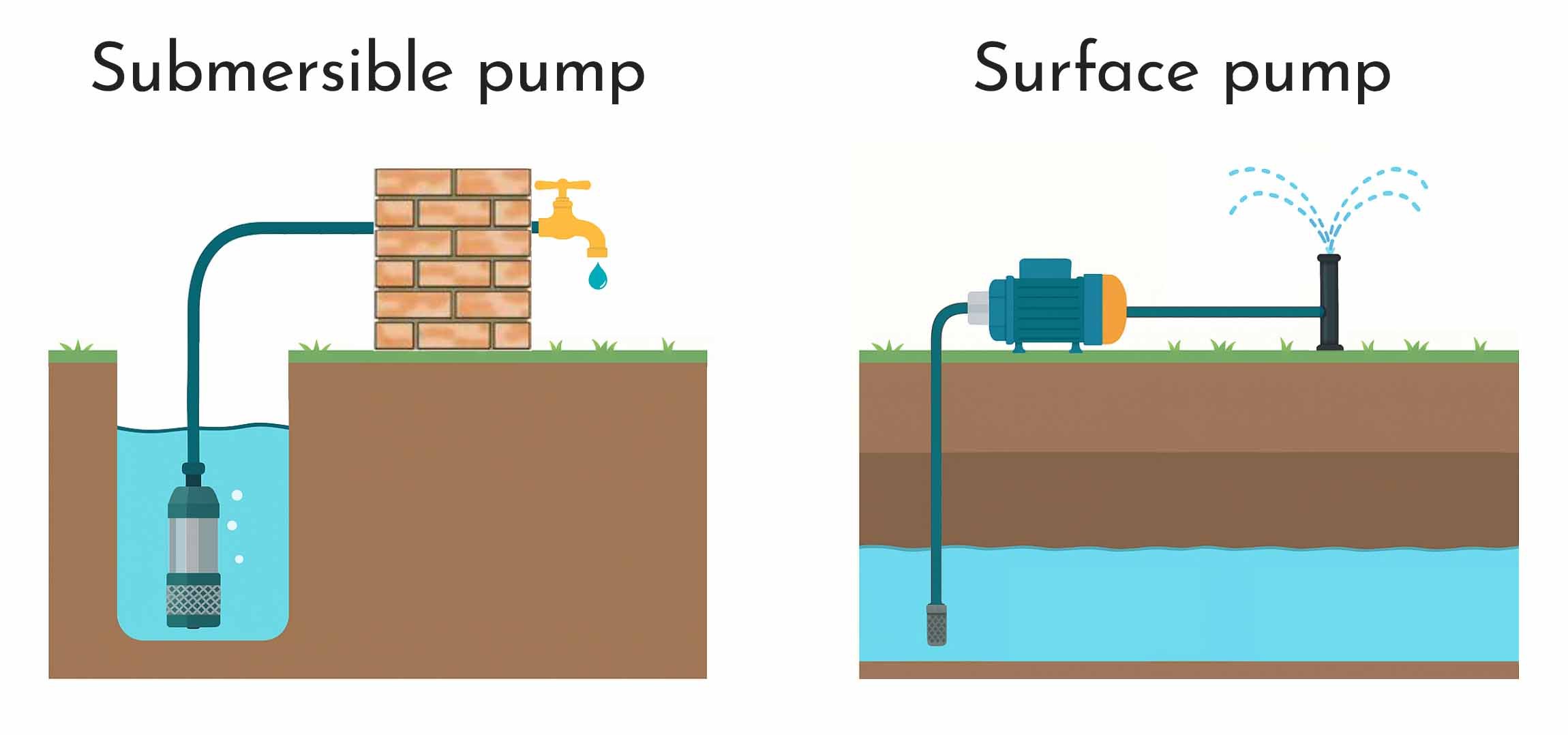Submersible pumps vs surface pumps: a practical guide.
Choosing the right water pump is crucial for any hydraulic system, whether domestic or industrial. An incorrect sizing or an unsuitable model can lead to high consumption, frequent failures and even complete system shutdown.
The two most common types are submersible pumps and surface pumps. Each has features, advantages and limits that make it more suitable for specific scenarios. In this guide we compare them, with practical examples to help you choose the best solution.
Submersible pumps: when they are really needed.
Submersible pumps are installed entirely underwater, inside a well or a tank. They are designed to bring water to the surface from great depths, ensuring continuity and quiet operation.
Advantages
- Very high suction depth → can work even beyond 200 meters.
- Low noise → ideal in residential areas.
- Durability and efficiency → water naturally cools the motor, avoiding overheating.
Disadvantages
- Higher initial cost compared to other solutions.
- More complex maintenance, as the pump must be extracted from the well for each intervention.
Practical example
Imagine a country house with a 40-meter-deep well: a surface pump would not be able to draw water. In this case, the only functional solution is to install a submersible pump, which guarantees constant pressure and flow up to the domestic system.

Surface pumps: practicality and convenience
Surface pumps are placed outside the water source and draw water through a suction pipe. They are suitable when the well or tank is not too deep.
Advantages
- Simple installation and maintenance → direct access reduces time and costs.
- Lower cost → reduced initial investment.
- Versatility → ideal for garden irrigation, vegetable gardens or small farms.
Disadvantages
- Limited suction depth → no more than 7–8 meters.
- Higher noise level.
- Possible priming problems in case of small air leaks.
Practical example
A farm that needs to power a greenhouse irrigation system from an open-air cistern (3 meters deep) can easily use a surface pump. The cost is lower, maintenance immediate and performance more than sufficient for the system.
Expert tip
When installing a surface pump, remember to place it as close as possible to the water source: fewer meters of suction pipe = less head loss, better efficiency and lower cavitation risk.
Comparison between submersible and surface pumps.
The direct comparison highlights some key differences:
- Depth of work: submersibles reach hundreds of meters, surface pumps stop at 7–8 meters.
- Installation: submersibles are hidden inside well or tank; surface pumps remain external and more accessible.
- Noise: almost none for submersibles, more noticeable for surface pumps.
- Maintenance: easy and immediate for surface pumps; more complex for submersibles.
- Cost: higher initial investment for submersibles, more affordable for surface pumps.
How to choose the right pump
To avoid mistakes, it is useful to ask yourself a few questions:
- What is the depth of the well or tank?
- Over 8 meters → submersible pump required.
- Under 8 meters → a surface pump may be enough.
- How often will you use the system?
- Continuous use → submersible, more resistant.
- Occasional use → surface, more economical.
- What are the noise and space constraints?
- In a villa, a submersible is almost imperceptible.
- In a farm or countryside, the noise of a surface pump is less critical.
- What budget is available?
- If the initial cost is a priority → surface pump.
- If durability and reliability are the goal → submersible pump.
Mistake to avoid
Many users choose a surface pump even for wells 15–20 meters deep. Result? The pump cannot draw water, overheats and gets damaged in a short time. Beyond 8 meters, the only solution is a submersible pump.
Conclusion
There is no one-size-fits-all answer: the choice between submersible pumps and surface pumps depends on depth, frequency of use, budget and installation context.
If you have a deep well and need quiet, continuous operation, the submersible pump is the right investment.
If you need an affordable and easy-to-access solution for garden irrigation or cistern emptying, a surface pump is the best choice.
Analyzing the hydraulic characteristics of your system and comparing technical data sheets is always the first step to a safe choice.

























